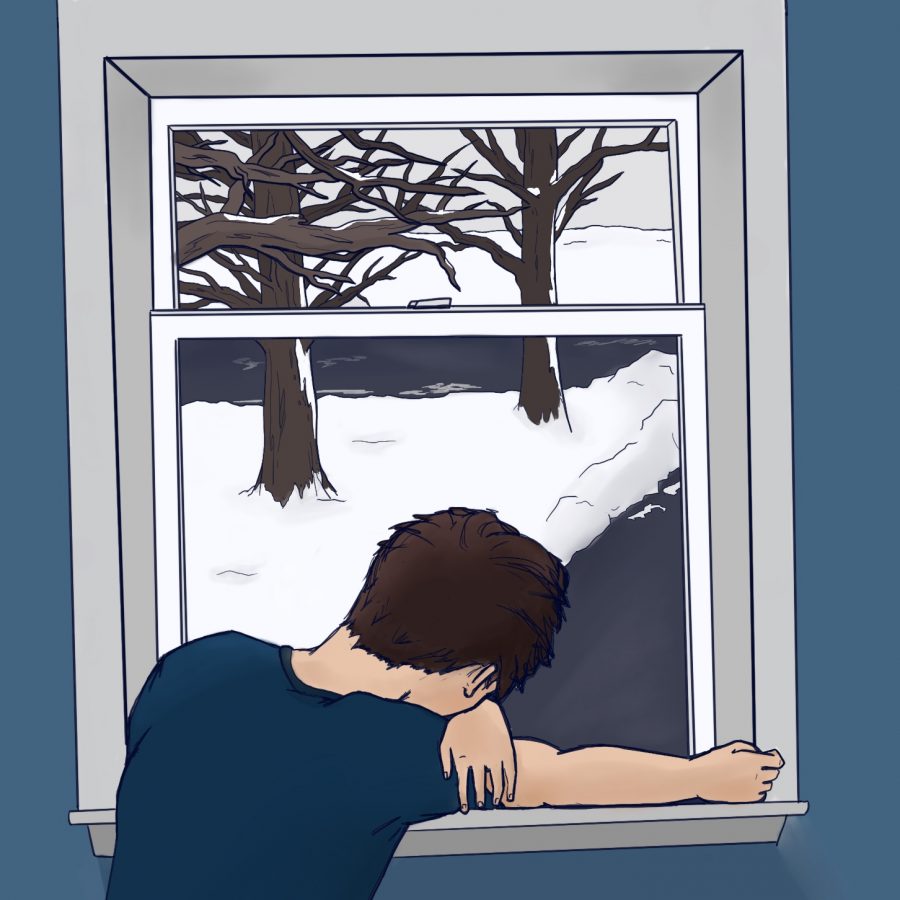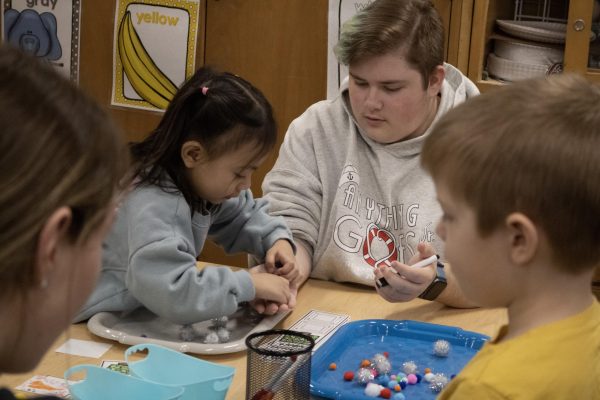Seasonal Affective Disorder: When is more than just the “winter blues”?
February 12, 2021
People can attest to the feeling of gloom that settles like the blanket of snow covering the ground while living through Chicago’s most infamous season. After months of the sun drifting off into darkness as soon as the school day ends, it is hard to see the light of spring at the end of a dark, long winter.
But when are these feelings more than just the “winter blues”?
Isolation from friends and family as well as changes in school performance can be indicators of a mental health condition such as depression, explained Dr. Maureen Keeshin, department chair of counseling psychology at The Chicago School of Professional Psychology. Keeshin added that feelings of hopelessness and a lack of motivation can also be signs to seek help.
“If the symptoms you are experiencing start to become problematic in your day-to-day life, then that would be a time to seek help,” Keeshin said.
One particular mental health disorder that affects around 10 percent of Illinois’ population is Seasonal Affective Disorder, according to Keeshin. Seasonal Affective Disorder (SAD) is a cyclical type of depression that affects a person during a certain season, typically winter, Keeshin noted.
“There is a lot less sunlight [at] the end of fall and [during] winter [which] can impact people’s mood,” Keeshin said. “People tend to be less active, particularly outdoors, because when people have less sunlight exposure, they tend to feel more lethargic and less motivated to engage in physical activities or things that are good for our health.”
Professional treatments for SAD include light therapy, psychotherapy, also known as talk therapy, and medication, according to the National Institute of Mental Health. Keeshin explained that light therapy works by increasing serotonin levels, a mood-stabilizing hormone. She added that exercise is also very beneficial for people with SAD because it releases endorphins.
“One of the neurotransmitters in our brain is serotonin and having lower levels of serotonin has been linked through research to depression,” Keeshin said. “A lack of sunlight depletes serotonin levels, which can [lead to] development of the onset of some depressive symptoms.”
Sophomore Alexa Malm, who has been professionally diagnosed with SAD, explained that while she had heard about SAD before her diagnosis, she did not understand the disorder until she took the time to research it. She stressed the importance of spreading awareness of SAD because it substantiates the daily struggles of people living with the disorder undiagnosed.
“It is very important to validate others feelings and spread awareness of it,” Malm said. “I didn’t know how common it was or really even what it was until I learned more about it.”
Before her diagnosis, Malm said she was confused as to why her experience in the winter was so different from her friends. However, receiving a professional diagnosis allowed her to accept her emotions.
“It validated what I [had] been feeling, and made me realize that it’s not a thing to be ashamed of,” Malm explained.
Meaningful discussions about this condition have been held in Elpida, a club at South dedicated to mental health, said Lucas Osterbur, chemistry teacher and co-sponsor of Elpida. Although it was not specifically labeled “Seasonal Affective Disorder” in their conversations, the club did talk about the challenges that students face in the winter months, Osterbur said.
“Students feel really dragged down in the months of October, November and December,” Osterbur explained. “Some people feel that they’re alone in feeling this way, [but] I think that many of us have that feeling.”
While sophomore Maggie Parsons has not been professionally diagnosed with SAD, she agreed with winter’s negative effects on even the simplest of tasks. Short days filled with gray skies take the joy out of everything, Parsons explained.
“Winter affects my levels of motivation, amount of happiness, and decision making,” Parsons said. “I find myself eating less and sleeping hours a day every afternoon just to avoid dealing with life.”
Elpida tries to focus on being a support system for those within the club, according to Osterbur. Holding group discussions and sharing experiences is a common activity. The club is also looking to expand to guest speakers who can attest to the struggles of mental health, Osterbur explained. Junior Luka Heidari, member of Elpida, is very passionate about mental health awareness. Having a club dedicated to mental health helps decrease the stigma around mental health, he explained. Getting rid of the negative stereotypes around disorders, like depression or anxiety, can make it easier for students to cope with them, which is exactly what Elpida aims to do, Heidari expressed.
“A lot of students were feeling like they were having issues with their mental health,” Heidari said. “I thought the club was a good way of [helping] with that.”
Junior Molly Heublein explained that although many people dislike talking about mental health, no one is alone in their struggles, moreover, stated a 2016 national survey of Children’s Health data, approximately one in six children aged six to 17 have a mental health disorder, as reported by aafp.org.
“[People] put a stigma around mental health that you have to deal with it on your own or that it is embarrassing, but it is not something you should be embarrassed about,” Hublein said. “A lot more people deal with it than you know.”
Despite the prevalence of mental disorders, many students, including Malm, are reluctant to discuss their struggles with mental health due to fear of a negative response from others. She explained that having SAD has made it more difficult for people to understand her feelings, and because of this, they have diminished her struggles as exaggerations.
“People say that you’re sad for no reason or you’re overreacting,” Malm said. “It’s definitely not that.”
Hublein urges people to talk to someone about their mental health and get involved. For Hublein, activities such as Chamber Singers have allowed her to escape from the stress weighing down on her, simply by laughing with her friends.
“I’ve met a bunch of people, and they’re all really supportive and they all make me laugh,” Hublein said. “I look forward to going to [each rehearsal] because my mind drifts away from stressors in my life.”
Similarly, Malm has found comfort in talking to the friends she knows will always be there to make her happy, especially in colder months. She acknowledged that what would have been a mindless conversation before has been made much more difficult by the pandemic, but she is still able to reach out through texting and FaceTime.
“Try and reach out to people who make you happy,” Malm said. “I try to keep in touch with my friends, [although] during the pandemic it has definitely been harder.”
Despite the difficulties of school, junior Yuna Batmunkh, who has not been diagnosed with SAD, said that extracurricular activities and hobbies are another source of relief from the stress building during the winter. From creating her own bullet journaling club to hobbies such as painting and reading, Batmunkh has found that staying busy helps to improve her mental health.
“If you are doing something that you enjoy, like clubs that excite you, it is definitely helpful for your [mental health],” Batmunkh added.
Parsons added that simple indoor activities can allow someone to escape from overwhelming feelings of hopelessness for even just a few minutes. She recommended a few that have helped her to increase her mood despite not having to take a step outside.
“I like to listen to music, read a book, take a hot shower or bake cookies,” Parsons said. “ These things really help me focus on myself and escape from reality for a little while.”
Parsons also emphasized the importance of having a support system, especially when going through long Chicago winters. She explained that this helps to remind her that there are other people having a similar experience as her, something that helps her to cope with struggles she faces.
“It’s important to know that everyone struggles with their mental health one way or another,” Parsons said. “You are nowhere near alone, and there is always someone going through the same thing as you.”
Having a support system and reaching out when you need help is something that Heidari emphasizes. Being able to be with the people he cared about has helped Heideri, even when he was at his lowest.
“[SAD] is very different for all students,” Heidari explained. “I don’t want anyone to feel like they have to go through it alone. It gets a lot better.”














